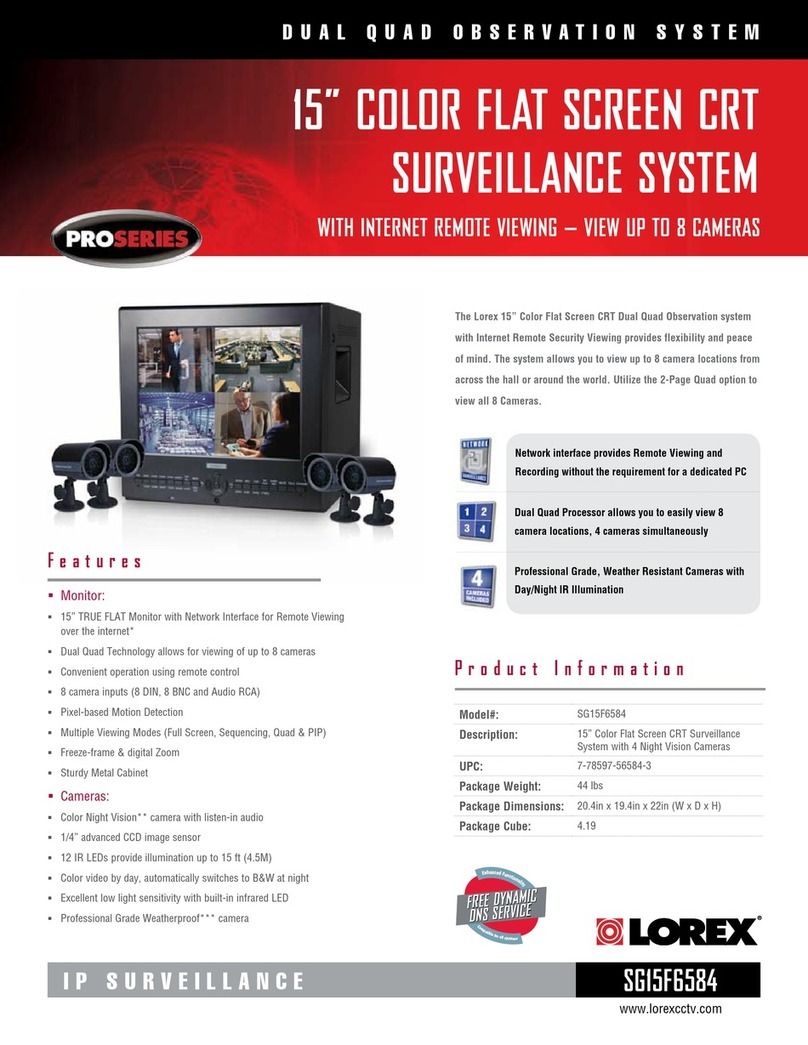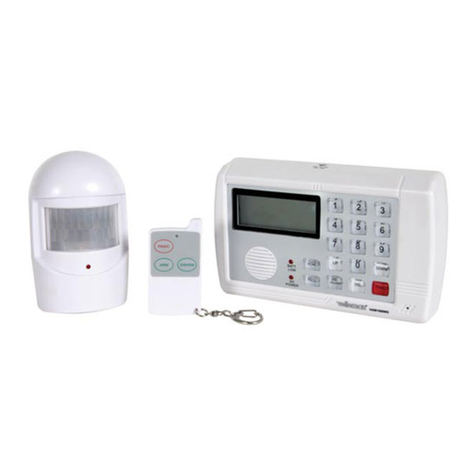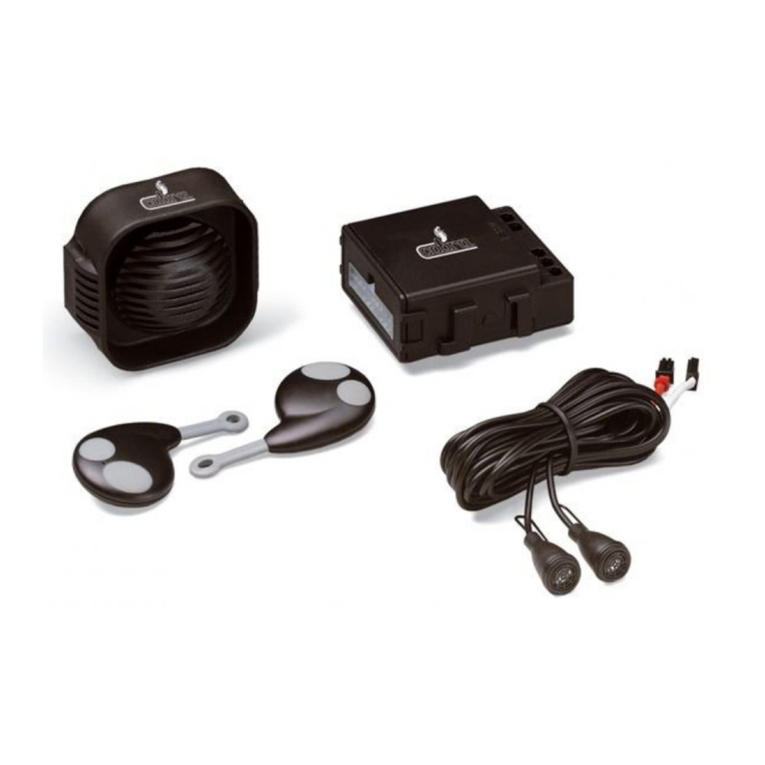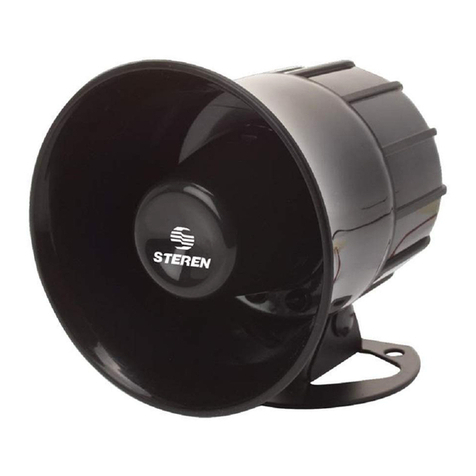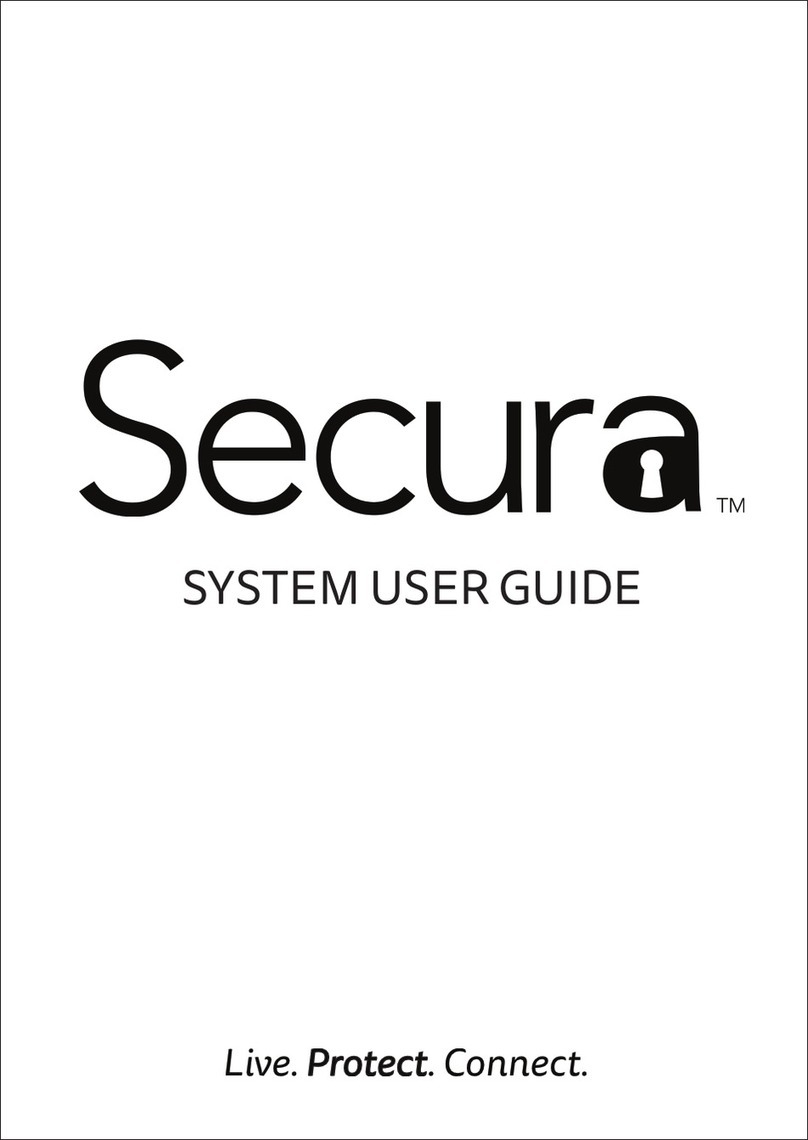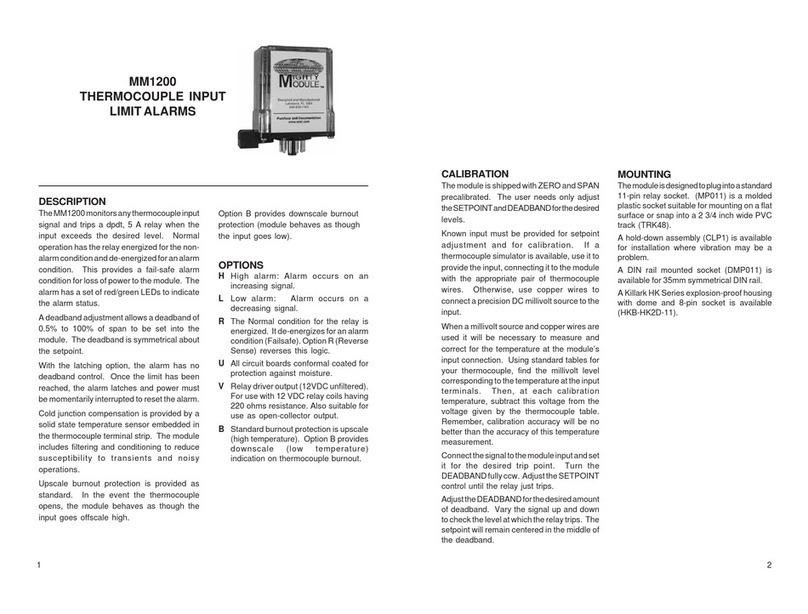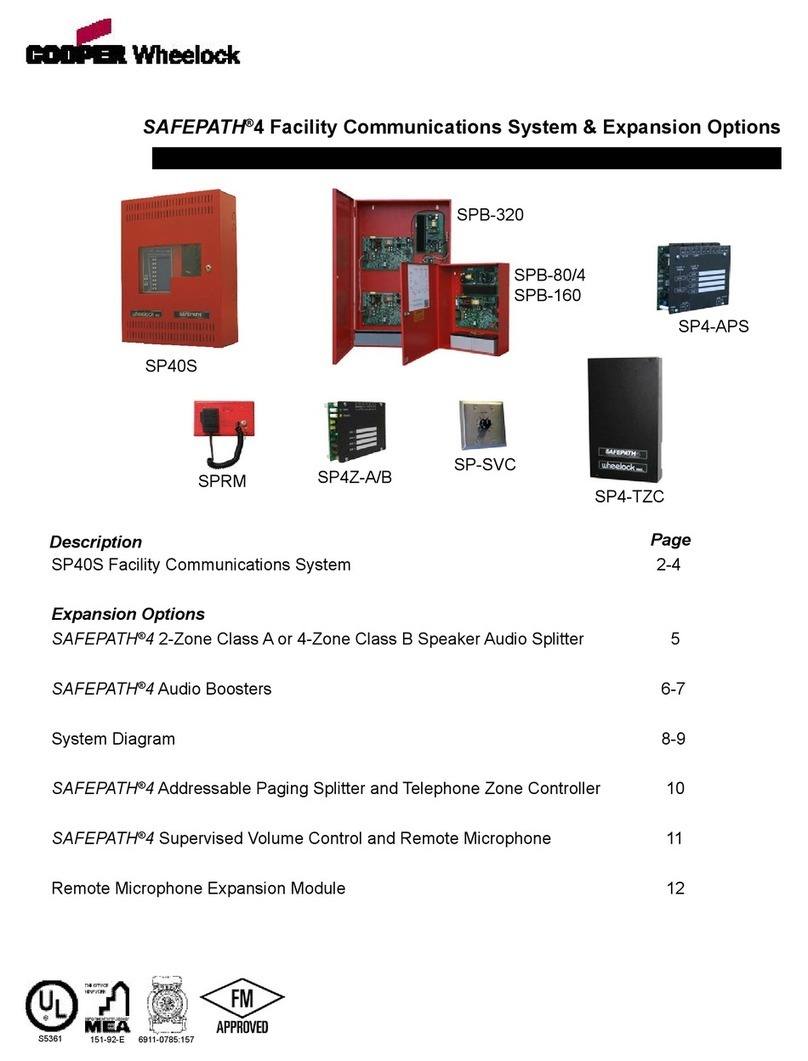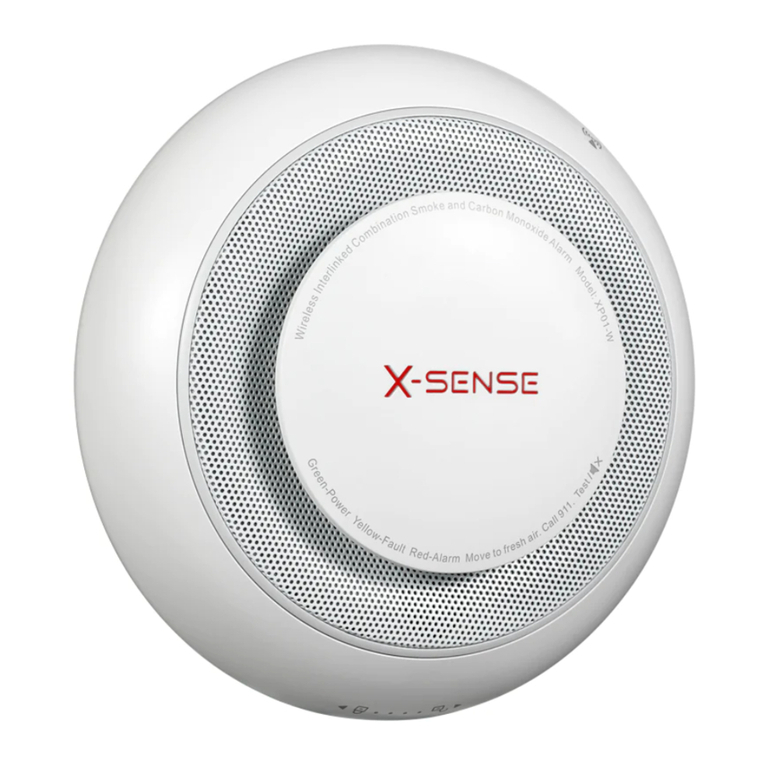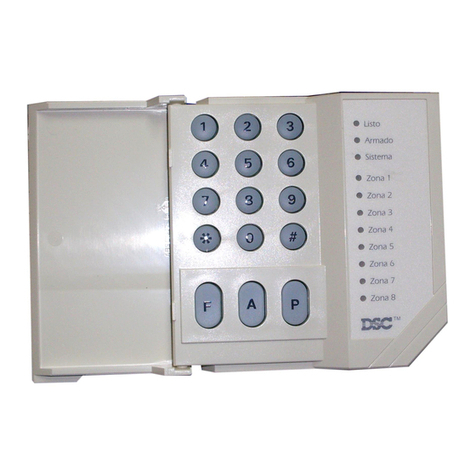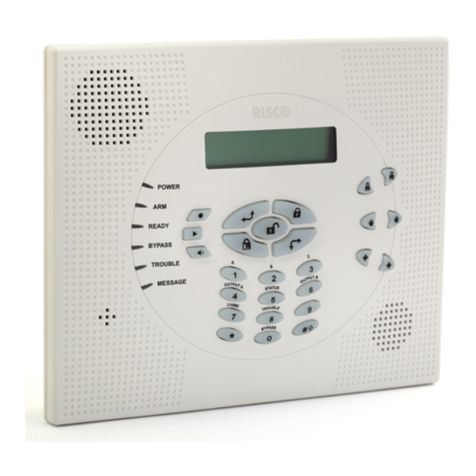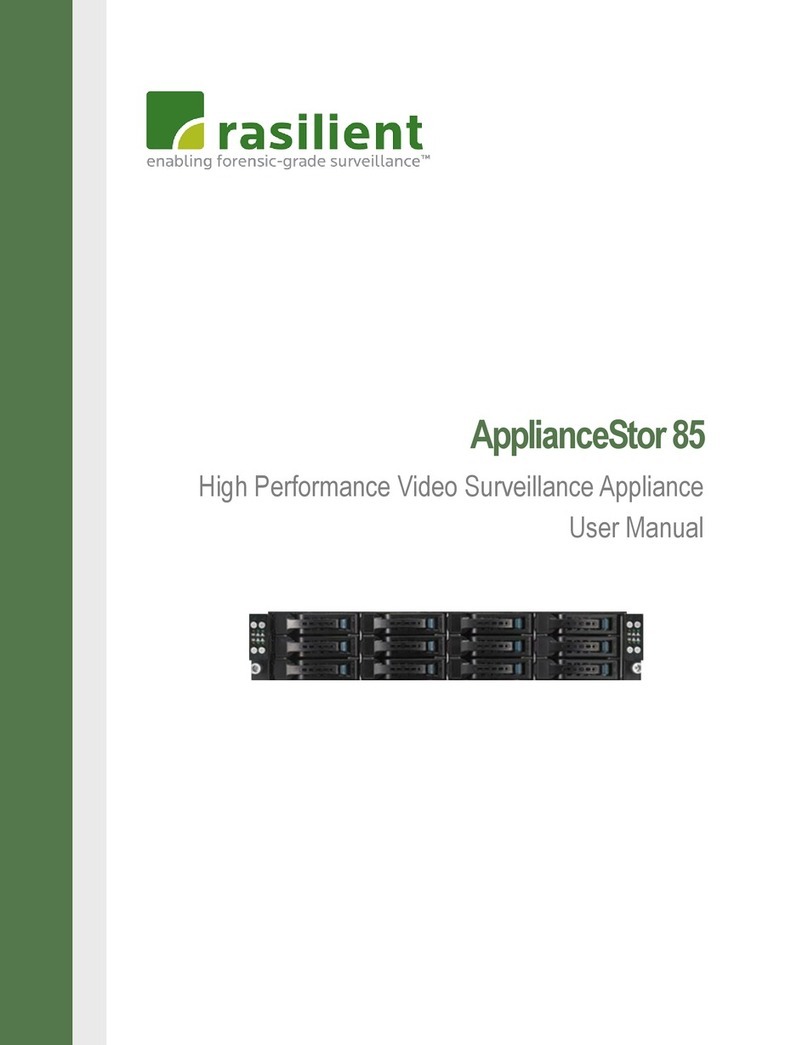Blyss BLY1 User manual

Wireless
Alarm
System
BLY1 Barcode 5397007039283
BLY1 Wireless Alarm
System - Version: 01
Wireless Alarm System.indd 1 01/06/2012 10:57

Getting started...
1
Getting started...
Let’s
get started...
These instructions are for your safety. Please read through them
thoroughly before use and retain them for future reference.
Getting started... 2
Introduction and Safety 3
Overview of System 4-5
Planning your Installation 6-8
Installing your System 5-15
In more detail... 16
Using the System 17-19
Maintenance 19
Extending the System 19
Specications 20-21
Troubleshooting Guide 21
Disposal and Recycling 22
Appendix 23
LED Alarm Indications 24
Zone-Location Table 25
BLY1 Wireless Alarm System
Wireless Alarm System.indd 2 01/06/2012 10:57

BLY1 Wireless Alarm System
Type box
2
Getting started...
Introduction and Safety 3
Overview of System 4-5
Planning your Installation 6-8
Installing your System 9-15
Getting
started...
Wireless Alarm System.indd 3 01/06/2012 10:57

Getting started...
3
INTRODUCTION
The wireless alarm system is designed to protect your home. It is a simple to use, easy to
install unit. No special tools or training are required, all xings are included.
Control panel, adaptor, movement detector and Door/Window contact are for indoor use only.
Avoid mounting location which can expose these product to splashing or dripping liquid.
SAFETY
Before proceeding with the installation, please note the following safety warnings:
DO NOT connect the mains supply directly to the products, this will cause
permanent damage to the products.
Always follow the manufacturer’s advice when using any tools power tools, ladder/steps,
using steps or ladders, and wear suitable protective equipment (e.g. safety goggles) when
drilling holes, etc.
The use of ear defenders are advisable when working in close proximity to the External
Siren or the Control Panel’s Siren when the front panel cover is removed due to the high
sound level produced by it.
Before drilling holes in walls, check for hidden electricity cables and water pipes. The use
of a cable/pipe locator is advisable if in doubt.
Batteries (battery pack or batteries installed) should not be exposed to excessive heat.
Danger of damage to the unit may occur if battery is incorrectly replaced.
Replace only with the same or equivalent type (Do not mix batteries type).
IE
Getting started...
Introduction & Safety BLY1 Wireless Alarm System
IMPORTANT: Please read this manual carefully, in full, before commencing
installation. You will nd installation easier if you follow these steps in the sequence
shown.
Wireless Alarm System.indd 4 01/06/2012 10:57

Kit Contents
You will need
This wireless alarm system is based on wireless radio technology to give exceptional levels
of protection and reliability. It has the ability to control up to eight detectors, three remote keys
(optional accessory) and one wireless siren.
4
Getting started...
Overview of System
BLY1 Wireless Alarm System
4mm 8mm
123
456
789
0
Learn
Part-Arm
POWER
Arm
Reset
Anti-Jam
On/Off
TAMPER
Control Unit
This is the heart of the system. It receives signals
from detectors, accepts inputs from user and
activates warnings such as siren and LED.
Wireless Magnetic Contact Detector (MC) (Two Pair)
Uses a magnetically operated switch to sense
the opening/closing of door or window.
Wireless Movement Detector (PIR)(One Unit)
The PIR uses Infra-Red technology to sense the
body heat of a moving person.
One unit can cover an entire room.
Wireless External Siren
Gives audible and visual indication
of an alarm condition.
External AC adaptor
1x 9V PP3 Alkaline battery
for Control unit backup
6x AAA 1.5V alkaline batteries
for MC and PIR
4 x D-Cell Alkaline batteries
for Wireless External Siren
Wireless Alarm System.indd 5 01/06/2012 10:57

Overview of System BLY1 Wireless Alarm System
5
Getting started...
• Detector /Key /External Siren learning – Every wireless device (detector, Key, External Siren)
contains an unique identication code. During installation, the control unit will learn which
devices belong within your system by receiving coded radio transmissions from each detector.
• This system can control up to eight detectors (every zone can control one wireless detector.)
If the system is triggered, the control unit will indicate which zone the alarm occurred.
• The wireless alarm system has three modes: OFF, Part-Arm, ARM; when entering ARM
or Part-Arm mode, the user has 30 seconds to leave the monitored areas without triggering
the alarm.
Zone – A logical area that is monitored by a detector.
Disarmed – (Standby mode) – This is the normal state of the system when the house is
occupied. Enter your four-digit user PIN code to return to OFF state.
Full Alarm – (ARM state) – The control unit will sound full alarm (internal siren) when it
receives alarm signals.
Part Arm – (Home state) – Arming the system so that certain zones omitted (i.e. will not trigger
an alarm). It is typically used to omit the upstairs zones at night when you sleep.
Entry/Exit Zone – The control unit recognise MC zone as entry and/or exit zone.
OK Beep – Rapid double tone; it indicates correct operation.
Error Beep – Long single tone; it indicates incorrect operation.
Anti-Jamming – Detect if jamming exists or not. it can be enabled/disabled
System features
Explanation of terms
Wireless Alarm System.indd 6 01/06/2012 10:57

6
Getting started...
Planning your Installation
BLY1 Wireless Alarm System
Location of components
Control unit – Location
In choosing a suitable location you should bear in mind:
• The need to reach the control unit easily, within the 30 seconds, when
entering and leaving the premises, ideally passing only one detector.
• The control unit should not be visible from the exterior of the protected
premises.
• Reception of radio signals can be affected by the presence of metal
objects within a few feet of the control unit. (E.g. mirrors, central
heating radiators, garage doors and cars parked in garages on the
opposite side of the wall). Avoid any location which is near (within 60cm)
to these or any other large metal objects.
Having chosen the location, do not mount at this stage.
Door/Window contact detector (MC) – Location
• These parts contain a radio transmitter and should not be sited near to
large metal objects.
• Contains two parts. The larger one (the actual detector) contains the
batteries and the electronics. The smaller part is simply a magnet inside.
• Designed to detect a door or window opening. The detector is usually
mounted next to it on the door or window. For optimum radio range,
they should be mounted as high as possible.
• In most applications, it is tted to the front door.
Having chosen the location, do not mount at this stage.
Movement/Passive infrared detector (PIR) – Location
• The detector should not be mounted near
to large metal objects or on metal surfaces.
It needs to be mounted on a wall or in corner
at a height of approximately 2-2.5 meters
for the best general coverage in an average
room. The detector has been designed to
avoid false alarms, nevertheless, it is best
to avoid installing the unit where it is facing
directly at sources of heat such as res
and boilers and always try to avoid facing at
the window. A PIR can look at a radiator but
should not be sited above it.
• Do not site a PIR where its eld of view
may be obstructed (e.g. by curtains). Also,
note that PIR works best when sensing a
movement across rather than along their detection beams.
• Allowing for pets – The PIR senses moving body heat. In some cases,
the movement of pets may also be detected. To overcome this it is
recommended that the pets are kept in one specic room out of sight of
a PIR when the system is armed. If required, additional MC (available
as accessories) can then be used to protect the doors and windows of
the room (see section 6 – Extending the System).
Having chosen the location, do not mount at this stage.
Fire Boiler Radiator
2m to 2.5m
Window
Wireless Alarm System.indd 7 01/06/2012 10:57

Planning your Installation BLY1 Wireless Alarm System
7
Getting started...
Planning the location of system components
Example of a domestic layout
The 2 sample layouts below are intended as guides only but demonstrate two examples of
how a house can be protected with the system.
Sample 1:
Zone Number Area Zone Area
1Front Door 5Area of the
control panel
2 Back Door 6 Bedroom 1
3 Window 7 Bedroom 2
4 Living Room 8 Bedroom 3
Front door
ZONE 1
Window
ZONE 3
Living
Room
ZONE 4
Bedroom
1
Bedroom
2
Bedroom
3Wirefree
External Siren
ZONE 6 ZONE 8
ZONE 7
Back Door
ZONE 2
Control Unit
Dinning
Room
ZONE 5
1st Floor
2nd Floor
Wireless Alarm System.indd 8 01/06/2012 10:57

8
Getting started...
Planning your Installation
BLY1 Wireless Alarm System
Zone Number Area Zone Area
1Front Door 5Area of the
control panel
2 Back Door 6 Kitchen
3 Window 7 Bedroom 2
4 Window 8 Bedroom 3
The PIRs have been separately placed in bedroom 1, bedroom 2, bedroom 3, and the area
where the control panel is installed, to protect these areas. The Door/Window contact detectors
have been positioned to protect the front door, back door and windows on the 1st oor.
Sample 2:
Front door
ZONE 1
Window
ZONE 4
Window
ZONE 3
Living
Room
Bedroom
1
Bedroom
2
Dining
Room
Wirefree
External Siren
ZONE 8
ZONE 7
Back Door
ZONE 2
Control Unit
Kitchen
ZONE 6
ZONE 5
T
he Zone 5 PIR has been placed in the dining room to protect this area where the control panel
is installed. The zone 6, 7, 8 PIRs have been separately placed in the kitchen, bedroom 1
and bedroom 2 to protect these area. Zone 6, 7 and 8 are set as “Home-Bypass zone” so that
these PIRs are disabled when the system is set to “Part Arm” mode. The Door/Window contact
detectors have been positioned to protect the front door, back door and windows.
When the system is installed for the rst time or any further detectors are learned to it at any
stage, please follow sections 3.1 to 3.5 explained in this manual to prevent the tamper function
from unnecessarily triggering the alarm of the control unit during installation.
Summary of the steps:
1. Install and power ON the control unit
2. Power up the wireless devices and link to the control unit
3. Power OFF the control unit
4. Install the detectors in their nal locations
5. Install the backup battery in the control unit and nally power up the control unit
Wireless Alarm System.indd 9 01/06/2012 10:57

Installing your System BLY1 Wireless Alarm System
9
Getting started...
Installing the Control unit
• Remove and retain the
two holding screws
from front cover of
control unit and
carefully hinge off
the front cover.
Fitting
• Place the
control unit
base mounting
plate on the wall at
the chosen location.
Mark and drill 4mm
holes for the two
mounting screws. Insert
wall plugs and have
the top mounting screw
screwed in to protrude
by about 5 to 6mm before hanging the control unit base mounting plate on wall.
• Align the control unit base mounting plate to vertical position before nal tightening of both
mounting screws.
Powering the Control unit
• Wire up the Main Power Adaptor to
the control unit, but DO NOT plugs the
adaptor into the main supply at this stage.
• Do not install the 9V back up battery
(provided with this kit) at this stage, but note its
installation position for later.
• Put back the front cover carefully and secure it
with the two holding screws, complete with the
screw covers (plugs).
• Power up the Main Power Adaptor to power
the control unit. The POWER LED will light up
and the TAMPER LED will ash since no
backup power is installed yet.
• If the alarm sounds then enter the factory user
PIN 1234 to silence the system.
Hole depth ˃22mm
Battery
Cover
Battery Clip
Battery
Compartment
External 15V
Adaptor
From External
15V Adaptor
Base Mounting
Plate Control Unit
6LR61 size
9V alkaline
battery
2 Pieces of M3 x 10mm
retaining screws
WARNING: The control
unit must never be
operated from the mains
with the front cover
opened. The user PIN
code is factory set to 1-2-
3-4. If the system sounds
during the installation,
pressing the factory set
code of 1-2-3-4 will silence
the system.
ST3x25KA
screw
5~6mm
protrude surface
Base Plate
2.6mm thick
98mm
Tighten the
screw to
fasten the
base plate on
surface
Wireless Alarm System.indd 10 01/06/2012 10:57

10
Getting started...
Installing your System
BLY1 Wireless Alarm System
Power up the Wireless Devices and learning to the CU
Before powering up the devices please read through this information regarding batteries:
1. An adult must carry out battery replacement and installation.
2. Remove exhausted batteries from this product.
3. Do not dispose of batteries in a re, batteries may explode
or leak.
4. Do not short-circuit the battery terminals.
5. Do not mix used and new batteries.
6. Do not mix alkaline standard (carbon-zinc), lithium or
rechargeable batteries.
7. Do not use rechargeable batteries in this product.
8. Do not recharge non-rechargeable batteries.
9. Do not allow any part to come in contact with heat or a direct ame.
10. Do not allow water to come into contact with the batteries or wiring.
11. Install carefully to prevent any damage to the batteries
12. When installing 2x (AAA 1.5V) batteries in the battery compartment, ensure the batteries are
placed as marked (+)(-).
13. Only the recommended batteries should be used.
14. Remove batteries from product when not in use for long periods of time.
15. Keep this product out of the reach of small children.
16. Store unused batteries in their original packaging.
17. Dispose of used batteries responsibly.
The wireless alarm system uses advanced radio technology that under most circumstances
will give more than sufcient transmission range. Before xing the control unit and
detectors in their selected install position, it is recommended to learn each wireless
detector to the control unit. Please follow the procedure below:
Powering up the wireless siren:
* The use of ear defenders is advisable at this stage *
1. Separate the siren’s front cover from the siren’s base to access the battery compartment.
2. Remove battery cover and insert four LR20 “D” size alkaline batteries in correct polarity as
shown indicated in the battery compartment. The siren’s LED will ash to indicate powered
up. Ret the battery cover taking care not to press and release the tamper switch located on
the rear of the siren’s back plate to prevent the siren from triggering an alarm.
3. If the tamper switch is accidentally press and released then move the power switch to the
‘OFF’ position as shown below to silence the alarm. However, move the switch back to ‘ON’
again ready for it to be learned by the control panel:
Battery cover
screw
“ON/OFF”
siren switch
Wireless Alarm System.indd 11 01/06/2012 10:57

Installing your System BLY1 Wireless Alarm System
11
Getting started...
Powering up the Wireless PIR Detector(s):
1. Remove battery cover and insert two LR03 “AAA” size alkaline batteries incorrect polarity
as shown.
2. Replace battery compartment cover.
When the PIR is rst powered up it will take 2 minutes for it to warm-up before it can be linked
to the control unit.
Linking the detectors to the Control unit.
1. Press and hold the “Learn” button for over 5 seconds in standby mode to enter learn
mode. The control unit will beep twice to conrm and the learn LED will turn on.
2. Trigger the device within 10 seconds ensuring it is kept at least 0.5m away from the control
unit. To trigger:
2.1 a magnetic contact, activate the MC detector by moving the magnet away
(greater than 40mm) from the arrow near the red LED.
When a MC Detector has been learnt successfully, Z1, Z2, Z3 or Z4 zone LED
(depending on which next zone is unprogrammed) will be constantly lit.
Learn MC
Greater than 40mm
NOTE: After the rst 2 minutes, the PIR will enter a test mode period for the next 15
minutes. During the test mode period, the PIR will constantly detect for movement so
that it gives enough time to link it to the control unit. When this period has expired,
after the PIR detects any further movement, it will go to sleep and not detect any
movement for 2 minutes. This is just an energy saving feature.
AAA 1.5V
AAA 1.5V
LR03 size 1.5V
LR03 size 1.5V
Wireless Alarm System.indd 12 01/06/2012 10:57

12
Getting started...
Installing your System
BLY1 Wireless Alarm System
2.2 a PIR Detector, trigger the PIR detector by simply moving your hand in
front of the detector.
When a PIR Detector has been learnt successfully, Z5, Z6, Z7 or Z8 zone LED depending on
which next zone is unprogrammed) will ash.
* The use of ear defenders is advisable at this stage*
2.3 a siren, press and release the tamper switch once located on the rear of the siren. The
siren will trigger an alarm. After the control unit conrms the siren is linked (both ‘Learn’
and ‘Z4/Z8’ LEDs will ash together), silence the siren again by moving its power switch
to ‘OFF’ again before installing it on the wall (see diagram on page 10).
2.4 a Remote Control, (Optional Accessory) press and release the disarm button once.
When the device is triggered, the rst available unprogrammed zone LED for that device
will light up on the control unit. The control unit will beep twice to conrm the device has been
learnt and the corresponding zone LED will light up red. (See diagrams below to show which
zone LEDs correspond to which device when learnt). If the device has not been triggered in 10
seconds then re-enter programming mode again (press and hold the “Learn” button for over
5 seconds)
Learn PIR
Learn PIR
Learn remote key
Wireless Alarm System.indd 13 01/06/2012 10:57

Installing your System BLY1 Wireless Alarm System
13
Getting started...
3. Trigger the next device within 10 seconds to learn it and repeat for additional devices. If the
system has reached its maximum capacity and no more devices ca be added. The control
unit will not beep any more.
4. When you have nished learning the devices, all zone LEDs will turn off after 10 seconds
which indicates successful programming. After this the system returns to standby mode.
Summary of the learn mode LED state
If you have any additional detectors, make sure they are programmed to the control unit
before location testing and installation.
Turn OFF the Main Power Adaptor so that the POWER LED on the Control unit is OFF.
a) Wireless magnetic Door/Window contact (MC) detector
1. Choose where on the door or window you wish to locate
the unit. The transmitter unit is usually mounted on the
frame and should be positioned such that the red LED is
close to the door or window.
2. The magnet should be tted as shown with one narrow
edge level with the at top on the detector housing.
The gap between the magnet and detector should not be
more than 8mm with the arrow on the magnet pointing directly towards the arrow on
the detector.
3. If there is insufcient room to mount the detector on the frame, then it can be
xed to the door or window instead (with the magnet xed to the frame
alongside it.) For reliable operation, the front face of the magnet should be no
more than 8mm from the front face of the detector. In some cases, it may be
necessary to place packing behind the magnet or detector to achieve this.
Fitting
4. Remove and retain the screw from the bottom of the detector. Use a small
drill or screw driver to make two xing holes in the back plate as a template.
Use the backplate to mark and drill two 4mm xing holes 80.5mm apart.
Fix the back plate in position using the screws provided.
5. If you wish add an additional wired magnetic Door/Window contact detector,
then connect the wiring to the two hard wire terminals provided.
Learn mode
state
Learn
Red LED
Z1/Z5
Red LED
Z2/Z6
Red LED
Z3/Z7
Red LED
Z4/Z8
Red LED
Learn
Wireless MC ON ON ON ON ON
Learn
Wireless PIR ON FLASH FLASH FLASH FLASH
Learn Wireless
Remote Key
(optional
accessory)
FLASH ON ON ON
Learn
Wireless
External
Siren
FLASH ON
Powering down the control unit
Installing your detectors
Max.
8mm Frame
52mm Door / Window
Wireless Alarm System.indd 14 01/06/2012 10:57

14
Getting started...
Installing your System
BLY1 Wireless Alarm System
4. Locate the detector on the back plate and replace the retaining screw at the base of
the unit.
5. Align the magnet as described above and x in position with the two screws provided.
b) Wireless Movement PIR Detector
1. Remove and retain the screw from the bottom of the PIR and lift off the cover.
Fitting
2. If you are tting the PIR in a corner, use mounting
points “A”. If you are tting the detector on to a at
surface, use mounting points “B”. The mounting
points are shown by indentations in the plastic
molding. Use a small drill to create two xing holes
at the mounting points.
3. Hold the base of the PIR in the chosen position,
ensuring that the front of PIR will face towards the
centre of the protected area, and mark and drill two
4mm xing holes in the wall. DO NOT drill holes
with the PIR in position – the resulting dust may
damage the PIR and prevent it from operating.
Secure the PIR to the wall using two screws
(25mm countersink) and the wall plugs.
4. Replace the electronic module into the retaining clips, ensuring that it is
correctly positioned and rmly seated.
c). Wireless external siren
Fitting
1. Mount the siren base on to the wall using screws or xings that are appropriate
for the construction of the building. Keyhole slots and slide mount are provided
to assist with positioning. It is recommended that all 3 xing points are used.
2. Once mounted, move the siren’s power switch to ‘ON’ again for normal
operation at this stage (see diagram on page 10).
Tamper protection xing
3. The tamper switch will touch against the wall, but will not ‘click’ in position at
this stage, provided the wall is a at surface.
4. When the front cover is tted and the cover screw moves further in, it will push
the wall tamper switch down against the wall making it ‘click’. This screw when
fully tightened, provides front cover and wall tamper protection.
A
B
NOTE: Each time this screw is removed, an alarm will be triggered by the system.
Silence the alarm by entering the user PIN code at the control panel
(factory set PIN 1234).*
NOTE: If you are tting the unit to a PVC door or window, you may wish to use
STRONG double-sided tape to x both detector and magnet in position.
80.5mm
Siren front cover Siren base Wall mounting points
Siren top view of front cover
screw when inserted pushes
down the tamper switch
Cover screw
Front
cover
retaining
screw
Wireless Alarm System.indd 15 01/06/2012 10:57

Installing your System BLY1 Wireless Alarm System
15
Getting started...
Movement Detector/PIR nal setup
The wireless PIR detector has a jumper link, which activates/deactivates the LED. This LED
can be used when performing a walk test in the chosen installation area to make sure you are
happy with detection coverage. To increase battery life, pull this link off after completing the
walk test. The LED will be off when the detector is triggered during arm. Otherwise, leave the
link on, the LED will be on when triggered.
1. While the control unit is powered OFF, remove the control unit front cover again
(see page 9)
2. Disconnect the battery snap connecting the battery holder. Take out the battery holder.
3. Connect the 9V Alkaline PP3 back up battery to the battery clip and place the battery
into its compartment section.
4. If the alarm sounds then enter the factory User PIN 1234 to silence the system
5. Ret the battery cover. Ret the control unit cover to the base.
6. Power up the main power adaptor again.
The control unit will return to standby ready for operation and the POWER LED will remain ON.
Powering up the control unit
IMPORTANT: To extend the battery life, wireless PIR detectors are designed to
detect once only before entering a “Sleep” condition for two minutes during which the
unit will not trigger. Any movement seen by the PIR during this period would cause
“Sleep” conditions to be extended by a further two minutes. Therefore, a wireless PIR
which is constantly sensing movement, such as a person walking around a room,
may appear to be non-functional; you will nd that the PIR will detect normally again
following a two minute period with no movement present.
Wireless Alarm System.indd 16 01/06/2012 10:57

Getting started...
Using the System 17-19
Maintenance 19
Extending the System 19
Specications 20-21
Troubleshooting Guide 21
Disposal and Recycling 22
Getting
started... In more
detail...
16
In more detail...
BLY1 Wireless Alarm System
Wireless Alarm System.indd 17 01/06/2012 10:57

Using the System BLY1 Wireless Alarm System
Control unit
When the control unit is powered up, it will remain in standby mode. The PIN code can
also disarm the system and put it into standby mode.
a) Changing the user PIN code
The User PIN code is factory set to 1234. It is highly recommended to change the user PIN
code immediately after completing the basic installation.
1. Set the system into “standby mode if not already set.
2. The following is a button sequence example of changing User PIN code to 6502:
Two short beeps from control unit conrm the operation. A long beep shows the request has not
been accepted or the waiting time between two buttons has exceeded 5 seconds.
*User PIN code of 0000 (four zeros) would lock this function. Pressing the reset switch
reverts the User PIN code to 1234 and unlocks this function.
b) Clear all programmed zones and reset User PIN code to default 1234
Pressing the reset switch inside the control unit clears all
programmed zones, keys and external siren and reverts the
user PIN code to 1234. It is necessary to open the control unit
cover by removing and retaining the two M3x10mm retaining
screws at the bottom of the control unit (please see section 3.1
for details).
c) Panic/Attack Alarm from control unit
Activated by pressing “Learn” button together with “Anti-Jam
On/Off”, the system will sound the alarm immediately for the
preset siren duration (3 minutes at the factory setting).
All four zone LEDs would be illuminated.
Enter User PIN code to return to standby mode.
Press “Reset” button to clear the zone LEDs.
d) Panic/Attack Alarm from Remote control key
(optional accessory)
Activated by pressing “PARTIAL ARM” button together with
“FULL ARM”, the system will sound the alarm
immediately for the preset siren duration (3 minutes
at the factory setting.) All four zone LED would be
illuminated. Pressing “Disarm” button will return it to
standby mode. Press “Reset” button at the Control
unit to clear the zone LEDs.
e) Silencing the system
1. When the alarm is triggered, enter the User PIN
code at the control unit or press “DISARM” button
at the remote key (optional accessory) to cancel
the alarm and return to standby.
2. If the alarm has not been cancelled, the alarm
sound will stop by itself after the preset siren duration time (3 minutes at the factory
setting), and the alarm hold indication (zone indicators) of the zone1 to zone 4 will be
illuminated, zone 5 to zone 8 will be ashed. Enter user PIN code at the control unit to
return or press “DISARM” button at the remote key (optional accessory) to return to
standby mode, press “Reset” button to clear the zone LEDs.
f) Arming the alarm system while exiting the house
Press “Arm” button at the control unit or press “FULL ARM” button at the remote key (optional
accessory), close the door and leave the house within the exit delay time (30 seconds at
factory setting), both PIR and magnetic contact are activated for protection after the exit
delay time elapsed. Note: The control unit will suspend the exit delay (30s) count down if the
door is opened or a PIR is triggered.
GB IE
17
In more detail...
Current User PIN Code New User PIN Code
Wireless Alarm System.indd 18 01/06/2012 10:57

18
Using the System
BLY1 Wireless Alarm System
In more detail...
g) Part Arm the alarm system while at home
Press “Part-Arm” button at the control unit or press “PARTIAL ARM” button at the remote
key, (optional accessory) close the door and leave the house within the exit delay time
(30 seconds at factory setting,) both PIR and magnetic contact are activated for protection
after the exit delay time elapsed. When omitted zones (zone 6 to zone 8 at factory setting)
are triggered, they will not activate the alarm. Part-arm can also be used when you are
sleeping upstairs at night and wish to protect the ground of your property provided the PIRs
of Zones 6-8 are installed upstairs.
When the system is part-armed. Zone 5 PIR is used to protect the area next to the control
panel with a delay period (30 seconds at factory setting).
h) Disarm the alarm system while entering the house
When you open the entrance door, the count down warning sound (entry delay time) will be
started. Enter your four-digit User PIN code at the control unit or press “DISARM” button
at the remote key (optional accessory) within the delay time (30 seconds at factory setting,)
system will return to standby mode. At any time, the user PIN code can be entered to set to
the standby mode.
1. Anti-Jamming detection feature
Press and hold the “Anti-Jam On/Off” button for over 10 seconds in standby mode to turn
anti-jamming function ON/OFF. The corresponding “Anti-Jam” green LED will turn ON/OFF.
Anti-Jam LED – Green colour (constantly on means enabled, Flashing means jamming
is detected)
Low battery detection
Control unit:
When the Control unit’s backup battery falls
below 7.2V to 7.6V for over one minute,
TAMPER LED will ash to show low battery
status.
PIR Detectors:
The PIR Detectors have a built in buzzer which
wills sound in the event of a low battery status.
Please replace the batteries within 2 weeks.
Magnetic Door/Window Contact Detectors:
The magnetic Door/Window contact detectors have a built in buzzer which wills sound in the
event of a low battery status. Please replace the batteries within 2 weeks.
When replacing any batteries, ensure you power OFF the control unit completely to prevent the
tamper function from triggering the alarm. After having replaced any batteries, reconnect the
Detector Part Arm
mode ARM mode Usage
Magnetic
Contact
Zone 1 Instant Delay
Exit/Entry
Zone
Zone 2 Instant Delay
Zone 3 Instant Delay
Zone 4 Instant Delay
PIR
Zone 5 Delay Delay Protect area far
away from
Exit/Entry Zone
Zone 6 Disable Delay
Zone 7 Disable Delay
Zone 8 Disable Delay
Summary of the detector responses in different mode
NOTE: If a door/window where a magnetic contact detector is installed (zones 1-4) is
opened, the alarm will activate instantly.
9V Alkaline
battery > One
minute
< 7.2V
~ 7.6V
Wireless Alarm System.indd 19 01/06/2012 10:57

Using the System/
Maintenance/
Extending the System
BLY1 Wireless Alarm System
19
In more detail...
Maintenance
Once every 3 months:
Test all detectors.
Additionally, once every two years:
It is suggested to replace all batteries in wireless detectors and the control unit.
Replace with the same type of battery:
PIR Detector: 2 x AAA 1.5V Alkaline batteries
Magnetic Contact Detector: 2 x AAA 1.5V Alkaline batteries
Remote Control (optional accessory): 1 x CR2032 Lithium coin cell
Siren: 4 x D cell Alkaline batteries
Control Unit: 9V PP3 Alkaline battery
When replacing any batteries, ensure the control unit is powered OFF completely.
Extending the system
A number of accessories are available to extend your system to suit your exact requirements.
When extending the system, please note the system can take up to 4 wireless magnetic Door/
Window contact detectors (in zones1-4), 4 PIR Detectors (in zones 5-8) and up to 3 wireless
remote controls.
Standard remote control (BLY4) – can be used to arm, part-arm, disarm or panic the control
unit system with an operating range of about 60 meters in open eld conditions. Please contact
your supplier for more information.
Standard PIR (BLY3) – easy to install, one unit protects a large area.
Standard Door/Window contact (BLY2) – easy to t, detects opening of a door or window, can
be extended by the addition of wired magnetic contact.
Default settings
Parameter Ex-factory Value
User PIN code 1234
Entry/Exit delay 30 seconds
Siren Duration 3 minutes
Zone allocation for PIR and MC Detectors
Zone 1 to 4 Magnetic Contact
Zone 5 to 8 PIRs
REMARK: It is recommended to replace the 9V alkaline battery in the control unit
after the AC power is out of service for a period of times.
Wireless Alarm System.indd 20 01/06/2012 10:57
Table of contents
